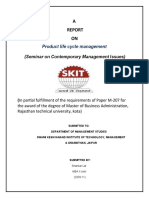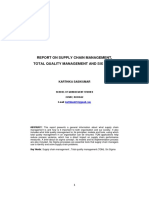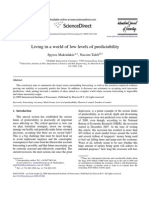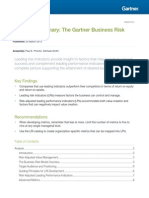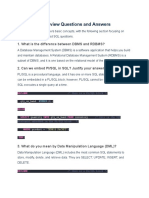An Information Silo: Management System Information System Information
An Information Silo: Management System Information System Information
Uploaded by
GeetanjaliCopyright:
Available Formats
An Information Silo: Management System Information System Information
An Information Silo: Management System Information System Information
Uploaded by
GeetanjaliOriginal Description:
Original Title
Copyright
Available Formats
Share this document
Did you find this document useful?
Is this content inappropriate?
Copyright:
Available Formats
An Information Silo: Management System Information System Information
An Information Silo: Management System Information System Information
Uploaded by
GeetanjaliCopyright:
Available Formats
An
information silo
An information silo, or a group of such silos, is an insular management system in
which one information system or subsystem is incapable of reciprocal operation
with others that are, or should be, related. Thus information is not adequately
shared but rather remains sequestered within each system or subsystem,
figuratively trapped within a container like grain is trapped within a silo: there may
be a lot of it, and it may be stacked quite high and freely available within those
limits, but it has no effect outside those limits. Such data silos are proving to be an
obstacle for businesses wishing to use data mining to make productive use of their
data.
Typical information silos in a hierarchic structured organization.
Information silos occur whenever a data system is incompatible or not integrated
with other data systems. This incompatibility may occur in the technical
architecture, in the application architecture, or in the data architecture of any data
system. However, since it has been shown that established data modeling methods
are the root cause of the data integration problem [1], most data systems are at least
incompatible in the data architecture layer.
Silo mentality[edit]
In management the term silo mentality often refers to information silos in
organizations. Silo mentality is caused by divergent goals of different
organizational units. It can also be described as a variant of the principal-agent
problem. Silo mentality preferably occurs in larger organizations and can lead to a
decreased performance and has a negative impact on the corporate culture. Silo
mentality can be countered by the introduction of shared goals, the increase of
internal networking activities and the flattening of hierarchies.[2]
Predictors for the occurrence of silos are
Number of employees
Number of organizational units within the whole organization
Degree of specialization
Number of different incentive mechanisms
This should not be confused with a data silo in computing, like application
virtualization, operating-system-level virtualization, or a separation kernel.
The term functional silo syndrome was coined in 1988 by Phil S. Ensor (1931–
2018) who worked in organizational development and employee relations
for Goodyear Tire and Rubber Company and Eaton Corporation, and as a
consultant. "Silo" and "stovepipe" (as in "stovepipe organization" and "stovepipe
system") are now used interchangeably and applied broadly. Phil Ensor's use of the
term "silo" reflects his rural Illinois origins and the many grain silos he would pass
on return visits as he contemplated the challenges of the modern organizations with
which he worked.
Information access and retrieval within most organizations is a work in progress.
There might be a general search system for marketing information, and probably
one or more database search systems.
The larger the organization, the greater the number of information retrieval
systems. Each laptop and mobile device has a search system. Mobile phone apps
sport their own search systems. The lawyers in an organization may have different
search systems for specific types of legal matters. The enterprise resource planning
(ERP) users have a search system. When it comes to enterprise search, there are
many silos.
A “silo” is a content collection available to certain users. In the face of the reality
of silos, it might be impractical idea of providing access to “all” information. “All”
may not mean all or even some available information. Big data is easy to talk about
but difficult to make accessible. The same challenge exists for images, audio
recordings, and engineering drawings with details hidden into the proprietary
system’s database.
Search which is variously called universal, unified or federated search is a solution
to the challenge of information silos. The term meta-search is often used to
describe an integrating function that passes the user’s query across discrete content
indexes and returns a single results list to the user. Endeca, Inxight Software,
Northern Light, Sagemaker and Vivisimo are search applications that can be used
for universal, unified or federated search in an organization.
The initial query might not unlock the information stored in the system’s index.
The facets, topics and suggests make it easy for the user to click through the links
without having to craft additional queries.
Behind the curtains, federated search results requires some maintenance. A user
does not want to know the file format in which the information he or she needs is
stored. The user wants answers. Early federating systems like WAIS relied on
standards for content representation. Today, however, there are many “standards,”
and content processing systems must be able to process content in the hundreds of
formats found in organizations.
It is important to deliver a system that makes an organization’s disparate types of
digital content available.
There are barriers to unified, federated or integrated search.
Some digital content cannot be included in a general purpose search system for
security, business or legal reasons. Technical content such as chemical structure
information at a pharmaceutical company requires special purpose systems. The
same need applies to product manufacturing data, legal information and
engineering drawings.
Most search applications exclude video streams from the index. If video is
indexed, the system processes the text included in the digital file or indexing
provided by the video owner.
The cost of creating connectors to connect with certain content types could be too
high, or license fees could be required to gain access to the file formats.
The computational burden required to process certain types of content might
exceed the organization’s ability to fund the content processing. Big data, for
example, requires a computing capability able to handle the Twitter stream, RSS
feeds and telemetry data from tracking devices. Cost could be prohibitive for
processing all content types.
The most important challenge is the need for confidentiality. The legal department
does not want unauthorized access to information related to a legal matter out of its
control. Some government contracts required that for certain types of government
work, the information related to that project must be separated. Common sense
dictates that plans for a new product and its pricing remain protected. If someone
needs access to that information, a different search system may be used to ensure
confidentiality.
Even in the absence of business or legal requirements, some professionals do not
want to share content. That may be a management problem. When a manager locks
up information in a no-access silo, a software script will skip the flagged server.
To summarize, silos of information present a challenge to process and effectively
use in organizations. In the enterprise, integration should take place within silos of
content.
You might also like
- Different Select Statements in SAP ABAPDocument4 pagesDifferent Select Statements in SAP ABAPMahmoud Diab100% (1)
- Exploring SAP Cloud ERPDocument74 pagesExploring SAP Cloud ERPGLEN KGATLANo ratings yet
- Dell Vs CompaqDocument1 pageDell Vs CompaqCHANDAN C KAMATHNo ratings yet
- TD Bank - IBM Case StudyDocument8 pagesTD Bank - IBM Case StudyArik RizerNo ratings yet
- 04 06 ART Process Portfolio Management Rosemann1Document4 pages04 06 ART Process Portfolio Management Rosemann1Mohd SaquibNo ratings yet
- Final ProjectDocument11 pagesFinal ProjectsoumyanicNo ratings yet
- Introduction To IAF - Cap GeminiDocument12 pagesIntroduction To IAF - Cap GeminiRhammania AdraNo ratings yet
- Handbook On Knowledge Management Knowledge Directions by Eric TsuiDocument10 pagesHandbook On Knowledge Management Knowledge Directions by Eric TsuiNabilah Mahardika PNo ratings yet
- Rangers ALM AssessmentDocument54 pagesRangers ALM AssessmentNandeeshNo ratings yet
- Impacts of Effective Data On Business Innovation and Growth Part 3Document14 pagesImpacts of Effective Data On Business Innovation and Growth Part 3Jyoti BhardwajNo ratings yet
- Section 2-1 #2 A-DDocument14 pagesSection 2-1 #2 A-DSonia Kaur100% (1)
- Swifttech DiagramsDocument10 pagesSwifttech DiagramsCROSTNo ratings yet
- 03 Employee DatabaseDocument11 pages03 Employee DatabaseGame MasterNo ratings yet
- Advanced DB Lecture All in One PDFDocument108 pagesAdvanced DB Lecture All in One PDFmelake mikru33% (3)
- Shankar Lal Scmi ReportDocument38 pagesShankar Lal Scmi ReportchintuoNo ratings yet
- Serial Key 2007Document3 pagesSerial Key 2007Vaishnavi MittalNo ratings yet
- AnalysisDocument15 pagesAnalysisshraddha vishwakarmaNo ratings yet
- A Product Information Modeling Framework For Product Lifecycle ManagementDocument18 pagesA Product Information Modeling Framework For Product Lifecycle ManagementHarsh ShahNo ratings yet
- Ford Value ChainDocument4 pagesFord Value ChainWaghela ManishNo ratings yet
- Glossary of Business TermsDocument20 pagesGlossary of Business TermsEmilee Rachael NicolaiNo ratings yet
- Adopted From CEU and University of Batangas During Our Training On Business AnalyticsDocument17 pagesAdopted From CEU and University of Batangas During Our Training On Business AnalyticsRyan de LeonNo ratings yet
- Business Relationships and NetworkingDocument54 pagesBusiness Relationships and NetworkingMetuge100% (1)
- PLM IntroDocument33 pagesPLM IntroGeetanjali100% (1)
- Sybase Data Architecture and Data Governance WPDocument8 pagesSybase Data Architecture and Data Governance WPArvind PeriyasamyNo ratings yet
- Session 1 Introduction CCRDocument20 pagesSession 1 Introduction CCRDHRUV DHHOCHAK IPM 2018 BatchNo ratings yet
- SCM TQM and Six SigmaDocument15 pagesSCM TQM and Six SigmaKarthika SasikumarNo ratings yet
- Volante Designer - DatasheetDocument3 pagesVolante Designer - DatasheetLuis YañezNo ratings yet
- B2 MMLDocument10 pagesB2 MMLvpascarielloNo ratings yet
- Oracle vs. SapDocument10 pagesOracle vs. SapRose Siena Simon AntioquiaNo ratings yet
- Management Information System (Mis) : 1. Technical ApproachDocument4 pagesManagement Information System (Mis) : 1. Technical ApproachPrashanth BnNo ratings yet
- Mi AssignmentDocument11 pagesMi AssignmentVarun MavaniNo ratings yet
- A Successful ERP Implementation Plan: Issues and ChallengesDocument53 pagesA Successful ERP Implementation Plan: Issues and Challengessachin15kalraNo ratings yet
- Living in A World of Low Levels of Predictability International Journal of Forecasting With N. TalebDocument5 pagesLiving in A World of Low Levels of Predictability International Journal of Forecasting With N. TalebPaulNo ratings yet
- ALM Evidences and ALM ROI CalculatorDocument8 pagesALM Evidences and ALM ROI CalculatorThomás HenriqueNo ratings yet
- Senior Management Policies: Organizational ChangeDocument10 pagesSenior Management Policies: Organizational ChangeAnonymous NnVgCXDwNo ratings yet
- The NGOSS Lifecycle and Methodology: Release 4.5Document51 pagesThe NGOSS Lifecycle and Methodology: Release 4.5MAGISTERSCNo ratings yet
- Winning Cloud Strategies GBE03890USENDocument24 pagesWinning Cloud Strategies GBE03890USENJeff ChauNo ratings yet
- Event Processing For Business Organizing The Real Time Enterprise PDFDocument2 pagesEvent Processing For Business Organizing The Real Time Enterprise PDFPamNo ratings yet
- ISYS90048 IT Infrastructure A01 Leony 649115Document11 pagesISYS90048 IT Infrastructure A01 Leony 649115Sactio SwastioyonoNo ratings yet
- Business Process RedesignDocument7 pagesBusiness Process RedesignAayush GargNo ratings yet
- E CommerceDocument78 pagesE CommerceAhmed Fayek100% (1)
- Magic Quadrant For Intelligent Business Process Management Suites 2015Document13 pagesMagic Quadrant For Intelligent Business Process Management Suites 2015dct1000No ratings yet
- SOA Essential PlaybookDocument7 pagesSOA Essential PlaybookshuebscribdNo ratings yet
- Conceptual Modeling For Information SystemsDocument28 pagesConceptual Modeling For Information SystemsgabilasticNo ratings yet
- A Collaboration Framework For Cross-Enterprise Business Process ManagementDocument12 pagesA Collaboration Framework For Cross-Enterprise Business Process ManagementkokojerryNo ratings yet
- Unit2 CloudDocument36 pagesUnit2 CloudRajveer SinghNo ratings yet
- Sample CRM QuestionsDocument49 pagesSample CRM QuestionsprashukNo ratings yet
- Hrai Center of ExcellenceDocument19 pagesHrai Center of ExcellenceCOTPOTNo ratings yet
- Icx C360exp RetailDocument183 pagesIcx C360exp Retail韩勇No ratings yet
- SOA SecurityDocument48 pagesSOA Securityapi-3829446No ratings yet
- Agile Software Development A Case Study of Web ApplicationDocument7 pagesAgile Software Development A Case Study of Web ApplicationsleshiNo ratings yet
- Executive Summary The Gartne 247514Document16 pagesExecutive Summary The Gartne 247514Mayur Malaviya100% (1)
- Unlock The Potential of Digitalization: Prakash Chandran President Director & CEO, Siemens IndonesiaDocument10 pagesUnlock The Potential of Digitalization: Prakash Chandran President Director & CEO, Siemens IndonesiaAgung SupriyantoNo ratings yet
- MIS Case Study Chapter 7Document17 pagesMIS Case Study Chapter 7Lorraine Anne Perez Calses100% (1)
- Taxonomy PresentationDocument28 pagesTaxonomy PresentationChiKita Tinitana100% (1)
- Software Development MethodologiesDocument26 pagesSoftware Development MethodologiesNana K. SarpongNo ratings yet
- The Edge Completes The Cloud: A Gartner Trend Insight ReportDocument26 pagesThe Edge Completes The Cloud: A Gartner Trend Insight Reportjuanito bananasNo ratings yet
- Mid Term (ERP) FinaleDocument6 pagesMid Term (ERP) Finaleحسين محمدNo ratings yet
- Amazon Operating Model PDFDocument6 pagesAmazon Operating Model PDFJiva TuksNo ratings yet
- Brochure - Digital Transformation in InsuranceDocument8 pagesBrochure - Digital Transformation in Insurancewahyu sinawangNo ratings yet
- Mejora ContinuaDocument14 pagesMejora ContinuaCharly PerezNo ratings yet
- Performance Management Systems - Proposing and TesDocument14 pagesPerformance Management Systems - Proposing and TesIrawaty AmirNo ratings yet
- Enterprise information system A Complete Guide - 2019 EditionFrom EverandEnterprise information system A Complete Guide - 2019 EditionNo ratings yet
- 02 Payslip 01.08.2024Document1 page02 Payslip 01.08.2024GeetanjaliNo ratings yet
- PLM IntroDocument33 pagesPLM IntroGeetanjali100% (1)
- Important: PLM Involves Both The Manufacturing of The Good and The Marketing of It.Document10 pagesImportant: PLM Involves Both The Manufacturing of The Good and The Marketing of It.GeetanjaliNo ratings yet
- PLM StrategyDocument1 pagePLM StrategyGeetanjaliNo ratings yet
- New Microsoft Word DocumentDocument1 pageNew Microsoft Word DocumentGeetanjaliNo ratings yet
- BLDEA's VP Dr. PGH College of Engineering and Technology, VijayapurDocument36 pagesBLDEA's VP Dr. PGH College of Engineering and Technology, VijayapurGeetanjaliNo ratings yet
- PLM Module 3Document2 pagesPLM Module 3GeetanjaliNo ratings yet
- VTU B.E B.tech 2019 8th Semester July CBCS 2015 Scheme MECH 15ME835 Product Life Cycle ManagementDocument2 pagesVTU B.E B.tech 2019 8th Semester July CBCS 2015 Scheme MECH 15ME835 Product Life Cycle ManagementGeetanjaliNo ratings yet
- Model Question Paper (CBCS) With Effect From 2015-16Document1 pageModel Question Paper (CBCS) With Effect From 2015-16GeetanjaliNo ratings yet
- Internship Report Data 2020Document5 pagesInternship Report Data 2020GeetanjaliNo ratings yet
- ? (Mandatory) (Mandatory) (Mandatory) (Mandatory) (Mandatory) (Mandatory) (Mandatory)Document3 pages? (Mandatory) (Mandatory) (Mandatory) (Mandatory) (Mandatory) (Mandatory) (Mandatory)GeetanjaliNo ratings yet
- Department of Mechanical Engineering Faculty Competence in All The Courses For The Academic Year 2020-21 (Responses) PDFDocument1 pageDepartment of Mechanical Engineering Faculty Competence in All The Courses For The Academic Year 2020-21 (Responses) PDFGeetanjaliNo ratings yet
- Research Details PDFDocument1 pageResearch Details PDFGeetanjaliNo ratings yet
- printMembershipCard HTMLDocument1 pageprintMembershipCard HTMLGeetanjaliNo ratings yet
- PLM 2020Document9 pagesPLM 2020GeetanjaliNo ratings yet
- G.V.PATIL - E CertificatesDocument2 pagesG.V.PATIL - E CertificatesGeetanjaliNo ratings yet
- AVISHKAR 2019 Validictory GVPDocument8 pagesAVISHKAR 2019 Validictory GVPGeetanjaliNo ratings yet
- Power BI QuestionsDocument14 pagesPower BI QuestionsBhagavan BangaloreNo ratings yet
- The Role of System Information Management (SIM) On Go-JekDocument13 pagesThe Role of System Information Management (SIM) On Go-JekFathinus Syafrizal100% (1)
- Databases 2 Course MaterialDocument13 pagesDatabases 2 Course MaterialcyliteNo ratings yet
- HR SchemaDocument12 pagesHR Schemagr8ganesh9401No ratings yet
- Unit-7 Transaction ProcessingDocument107 pagesUnit-7 Transaction ProcessingShiv PatelNo ratings yet
- Data Base Chapter 1 - IotDocument10 pagesData Base Chapter 1 - IotbUrA f13kNo ratings yet
- CrudDocument7 pagesCrudResdiyant GankNo ratings yet
- Relational Databases and BeyondDocument12 pagesRelational Databases and BeyondaNo ratings yet
- Veritas Netbackup and Zerto Buyer'S Guide and Reviews July 2021Document36 pagesVeritas Netbackup and Zerto Buyer'S Guide and Reviews July 2021Soufiane CHAHBOUNNo ratings yet
- Ppqa External AssessmentDocument4 pagesPpqa External AssessmentSabahat Hussain100% (2)
- Chapter 1 DBMSDocument32 pagesChapter 1 DBMSAishwarya Pandey100% (1)
- Redgate Transact SQL The Building Blocks To SQL Server ProgrammingDocument169 pagesRedgate Transact SQL The Building Blocks To SQL Server Programmingsyahri ardiNo ratings yet
- UNIT IV-CC-NotesDocument18 pagesUNIT IV-CC-NotesrahulNo ratings yet
- Vinoth TDMDocument4 pagesVinoth TDMGokul RavichandranNo ratings yet
- SCM For Business ImpactDocument2 pagesSCM For Business ImpactKARTHIYAENI VNo ratings yet
- Implementing Information Security Based On Iso 27001 Iso 27002 A Management GuideDocument27 pagesImplementing Information Security Based On Iso 27001 Iso 27002 A Management Guidedimkatsar3060% (5)
- 22 5COSC020W LECT03 MappingDocument34 pages22 5COSC020W LECT03 MappingKunle Asekunola AbiodunNo ratings yet
- File System Vs DBMSDocument6 pagesFile System Vs DBMSSahilNo ratings yet
- SQL Interview Questions Cheat SheetDocument32 pagesSQL Interview Questions Cheat SheetshivanNo ratings yet
- Agile MethodologiesDocument3 pagesAgile MethodologiesEditor IJTSRDNo ratings yet
- Concurrency Control Techniques: By, Dr. P. Gayathri Associate Professor Scope VIT UniversityDocument35 pagesConcurrency Control Techniques: By, Dr. P. Gayathri Associate Professor Scope VIT UniversityPuneeth PuligundlaNo ratings yet
- Chatgpt MCQDocument35 pagesChatgpt MCQRoza MulukenNo ratings yet
- Why Use Iteration/Incremental Model?Document4 pagesWhy Use Iteration/Incremental Model?Koh TongyiNo ratings yet
- 4 ImbokDocument26 pages4 ImbokDonna HernandezNo ratings yet
- Problem 3:: Ref: Homework Assignment. The George Washington University (Csci 243 - Data Mining, Spring 2007)Document2 pagesProblem 3:: Ref: Homework Assignment. The George Washington University (Csci 243 - Data Mining, Spring 2007)slogeshwariNo ratings yet














